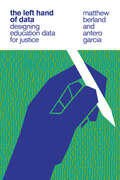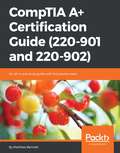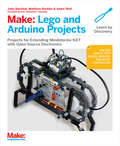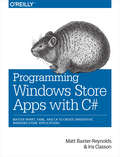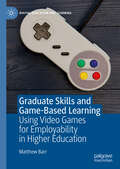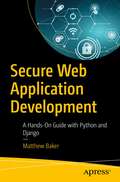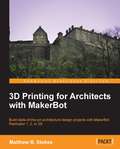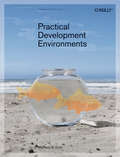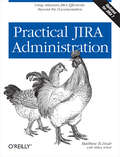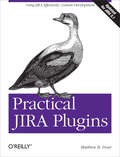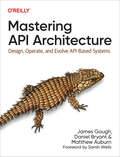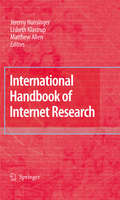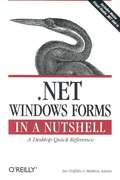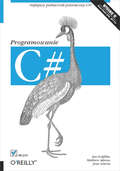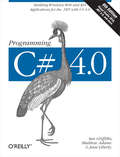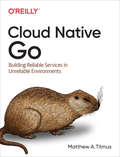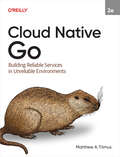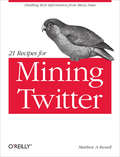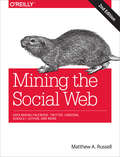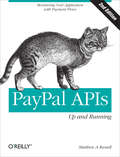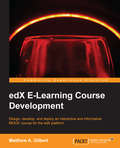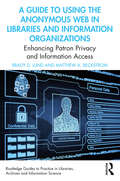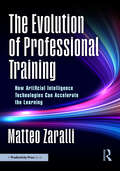- Table View
- List View
The Left Hand of Data: Designing Education Data for Justice
by Antero Garcia Matthew BerlandA speculative framework that imagines how we can use education data to promote play, creativity, and social justice over normativity and conformity.Educational analytics tend toward aggregation, asking what a &“normative&” learner does. In The Left Hand of Data, educational researchers Matthew Berland and Antero Garcia start from a different assumption—that outliers are, and must be treated as, valued individuals. Berland and Garcia argue that the aim of analytics should not be about enforcing and entrenching norms but about using data science to break new ground and enable play and creativity. From this speculative vantage point, they ask how we can go about living alongside data in a better way, in a more just way, while also building on the existing technologies and our knowledge of the present.The Left Hand of Data explores the many ways in which we use data to shape the possible futures of young people—in schools, in informal learning environments, in colleges, in libraries, and with educational games. It considers the processes by which students are sorted, labeled, categorized, and intervened upon using the bevy of data extracted and collected from individuals and groups, anonymously or identifiably. When, how, and with what biases are these data collected and utilized? What decisions must educational researchers make around data in an era of high-stakes assessment, surveillance, and rising inequities tied to race, class, gender, and other intersectional factors? How are these complex considerations around data changing in the rapidly evolving world of machine learning, AI, and emerging fields of educational data science? The surprising answers the authors discover in their research make clear that we do not need to wait for a hazy tomorrow to do better today.
The Photographic Garden: Mastering the Art of Digital Garden Photography
by Matthew BensonThe garden is a rich canvas of visual ideas, all waiting to be skillfully captured and evoked by the camera. With in-depth discussions on creative technique and technical literacy, The Photographic Garden is an inspiring guide for understanding the complexities of light and design in the garden and a primer on the latest digital image-making tools, from cameras to postproduction software. Professional photographer Matthew Benson shows you how to become a better, more intuitive artist in the landscape; helps you foster a deeper understanding of design and aesthetics; and encourages you to develop your own visual sensibility—through hundreds of his own thoughtprovoking, evocative garden images. You'll learn how to explore the garden with your camera; how to apply the fundamentals of composition, light, and color to image-making; and how to use digital technology to improve and enhance (and even rescue!) the images you've taken. Most of all, you'll be motivated to see like a camera, work like a professional, and imagine and create like an artist.
CompTIA A+ Certification Guide (220-901 and 220-902)
by Matthew BennettEfficiently clear CompTIA 220-901 and 220-902 certification About This Book • Your CompTIA A+ study companion to take the test with complete confidence • Full practice tests with complete real-time progress • Prepare smarter and faster with Packt Cert Series, customize your learning to strengthen your weak areas Who This Book Is For This book is aimed to people who have an interest in a career in the IT industry but currently have little or no practical experience to attest to your skills. Most of our delegates go on to work as 1st Line IT Technicians and from this point establish a career through the organisational structure to later specialize in specific IT technologies. However you're not ready for that yet. With your screwdriver in one hand and the book in the other, let's get you to a position where you can prove that you are both confident and competent. What You Will Learn • Validate your skills and boost your career with CompTIA A+ • Learn all concepts raised by the A+ certification • Understanding and installing CompTIA hardware required for CompTIA A+ 220-901. • Install and configure an Operating System on a client/desktop, covering a range of mobile and network devices and platforms • Learn how to secure a workstation and troubleshoot any security related issues In Detail The book is divided into two modules. The first course covers content for the CompTIA A+ exam 220-901 and about the second covers additional content for the CompTIA A+ 220-901. In the first course, you will first begin with the understanding and installing CompTIA hardware required for CompTIA A+ 220-901. Next you will learn to use appropriate networking tools based on different scenarios. Toward the end you will learn about different domains such as Mobile Devices, Hardware and Network Troubleshooting. In the second course you will look at how to install and configure an Operating System on a client/desktop, covering a range of mobile and network devices and platforms. Perform common preventive maintenance procedures using the appropriate Windows OS tools and you would also learn to perform the same tasks with other OS. Finally you will learn about security best practices to secure a workstation and also troubleshoot any PC OS issues, application issues or security issues. Style and Approach The book is divided into 11 chapters. Together, these cover the 901 and 902 courses in completion. The chapters are each a specific objective for the exams. The chapter is further subdivided by category as detailed in the Exam Objectives.
Make: Projects for extending MINDSTORMS NXT with open-source electronics
by Adam Wolf John Baichtal Matthew BecklerMake amazing robots and gadgets with two of today’s hottest DIY technologies. With this easy-to-follow guide, you’ll learn how to build devices with Lego Mindstorms NXT 2.0, the Arduino prototyping platform, and some add-on components to bridge the two. Mindstorms alone lets you create incredible gadgets. Bring in Arduino for some jaw-dropping functionality—and open a whole new world of possibilities.Build a drink dispenser, music synthesizer, wireless lamp, and moreEach fun and fascinating project includes step-by-step instructions and clear illustrations to guide you through the process. Learn how to set up an Arduino programming environment, download the sketches and libraries you need, and work with Arduino’s language for non-programmers. It’s a perfect book for students, teachers, hobbyists, makers, hackers, and kids of all ages.Build a Drawbot that roams around and traces its path with a marker penConstruct an analog Mindstorms clock with hands that display the correct timeCreate a machine that mixes a glass of chocolate milk at the touch of a buttonMake a Gripperbot rolling robotic arm that you control wirelessly with Arduinos mounted on your armsExplore electronic music by building a guitar-shaped Lego synthesizerBuild a Lego lamp with on/off and dimmer switches that you control with a smartphone applicationJump feet first into the world of electronics, from learning Ohm’s Law to working with basic componentsYou'll need the Bricktronics shield created for this book by Open Source Hardware kit maker Wayne and Layne, or you can build a breadboarded equivalent (see Chapter 10) for about $25 in parts.
Programming Windows Store Apps with C#: Master WinRT, XAML, and C# to Create Innovative Windows 8 Applications
by Iris Classon Matthew Baxter-ReynoldsIf you’re a .NET developer looking to build tablet apps, this practical book takes you step-by-step through the process of developing apps for the Windows Store. You’ll learn how to use Microsoft’s Modern UI design language with Windows 8.1 and WinRT 8.1.1 by building a line-of-business mobile app with C# through the course of the book.To develop the app, you’ll work with the same system details and design specs that apply to retail apps, such as persistence, backend service, and Windows 8 features for sharing and search. You’ll learn how to develop the code, incorporate third-party open source products, and package your app for the Windows Store.Build a UI with XAML and the Model/View/View-Model patternUnderstand asynchrony—and rediscover threads and parallelismStore data and system settings locally with SQLiteUse app bars for commands and the settings charm for Help optionsPresent notifications as tile updates, badges, or toast popupsHelp users visualize locations and tag activities to a mapEnable apps to share data and run side-by-side in the UIImplement functionality for running tasks in the background
Graduate Skills and Game-Based Learning: Using Video Games for Employability in Higher Education (Digital Education and Learning)
by Matthew BarrThis book explores the efficacy of game-based learning to develop university students’ skills and competencies. While writing on game-based learning has previously emphasised the use of games developed specifically for educational purposes, this book fills an important gap in the literature by focusing on commercial games such as World of Warcraft and Minecraft. Underpinned by robust empirical evidence, the author demonstrates that the current negative perception of video games is ill-informed, and in fact these games can be important tools to develop graduate skills related to employability. Speaking to very current concerns about the employability of higher education graduates and the skills that university is intended to develop, this book also explores the attitudes to game-based learning as expressed by instructors, students and game developers.
Secure Web Application Development: A Hands-On Guide with Python and Django
by Matthew BakerCyberattacks are becoming more commonplace and the Open Web Application Security Project (OWASP), estimates 94% of sites have flaws in their access control alone. Attacks evolve to work around new defenses, and defenses must evolve to remain effective. Developers need to understand the fundamentals of attacks and defenses in order to comprehend new techniques as they become available. This book teaches you how to write secure web applications.The focus is highlighting how hackers attack applications along with a broad arsenal of defenses. This will enable you to pick appropriate techniques to close vulnerabilities while still providing users with their needed functionality.Topics covered include:A framework for deciding what needs to be protected and how stronglyConfiguring services such as databases and web serversSafe use of HTTP methods such as GET, POST, etc, cookies and use of HTTPSSafe REST APIsServer-side attacks and defenses such as injection and cross-site scriptingClient-side attacks and defenses such as cross-site request forgerySecurity techniques such as CORS, CSPPassword management, authentication and authorization, including OAuth2Best practices for dangerous operations such as password change and resetUse of third-party components and supply chain security (Git, CI/CD etc)What You'll LearnReview the defenses that can used to prevent attacksModel risks to better understand what to defend and howChoose appropriate techniques to defend against attacksImplement defenses in Python/Django applicationsWho This Book Is ForDevelopers who already know how to build web applications but need to know more about securityNon-professional software engineers, such as scientists, who must develop web tools and want to make their algorithms available to a wider audience.Engineers and managers who are responsible for their product/company technical security policy
3D Printing for Architects with MakerBot
by Matthew B. StokesThis is a hands-on tutorial for a user to become well-versed with 3D printing using MakerBots."3D Printing for Architects with MakerBot" is ideal for architects looking to creating stunning prototypes using the MakerBot Replicator 2X 3D printer. Having experience using 3D CAD software is beneficial but not necessary as this book mentions several different CAD packages for beginners, up to those more advanced users who are perhaps looking for additional features.
Practical Development Environments
by Matthew B. DoarThis book doesn't tell you how to write faster code, or how to write code with fewer memory leaks, or even how to debug code at all. What it does tell you is how to build your product in better ways, how to keep track of the code that you write, and how to track the bugs in your code. Plus some more things you'll wish you had known before starting a project.Practical Development Environments is a guide, a collection of advice about real development environments for small to medium-sized projects and groups. Each of the chapters considers a different kind of tool - tools for tracking versions of files, build tools, testing tools, bug-tracking tools, tools for creating documentation, and tools for creating packaged releases. Each chapter discusses what you should look for in that kind of tool and what to avoid, and also describes some good ideas, bad ideas, and annoying experiences for each area. Specific instances of each type of tool are described in enough detail so that you can decide which ones you want to investigate further.Developers want to write code, not maintain makefiles. Writers want to write content instead of manage templates. IT provides machines, but doesn't have time to maintain all the different tools. Managers want the product to move smoothly from development to release, and are interested in tools to help this happen more often. Whether as a full-time position or just because they are helpful, all projects have toolsmiths: making choices about tools, installing them, and then maintaining the tools that everyone else depends upon. This book is especially for everyone who ends up being a toolsmith for his or her group.
Practical JIRA Administration: Using JIRA Effectively: Beyond the Documentation
by Matthew B. DoarIf you're familiar with JIRA for issue tracking, bug tracking, and other uses, you know it can sometimes be tricky to set up and manage. In this concise book, software toolsmith Matt Doar clarifies some of the more confusing aspects by answering difficult and frequently asked questions about JIRA administration.Practical JIRA Administration shows you how JIRA is intended to be used, making it an ideal supplement to the extensive documentation already available. The book’s chapters are loosely connected, so you can go straight to the information that best serves your needs.Understand the difference between JIRA groups and JIRA project rolesDiscover what JIRA schemes do, and learn how to maintain themUse a consistent configuration approach to help you use JIRA as a platformCreate a workflow from scratchAdd, modify, and deactivate usersPrepare for a JIRA upgrade, and troubleshoot if necessaryGet remote access to JIRA via email, SQL, REST, and other methods
Practical JIRA Plugins: Using JIRA Effectively: Custom Development
by Matthew B. DoarOne advantage of using JIRA for issue tracking, bug tracking, or project management is the ability to extend this tool with hundreds of plugins from the JIRA community. In this concise book, software toolsmith Matt Doar—the author of Practical JIRA Administration—shows you how to create and maintain your own JIRA plugins to meet the specific needs of a project.This book uses detailed examples to clarify some of the more confusing aspects of JIRA plugins, and serves as an ideal supplement to the extensive documentation already available.Use JIRA’s Plugin SDK, and learn several aspects common to all pluginsCreate your own custom field type, using a JIRA pluginDelve into advanced aspects of custom field plugins, and discover how searching for values in custom fields worksCreate JIRA plugins to use with workflows, and learn about conditions, validators, and post-functionsStore data using the PropertySet interface and the Active Objects pluginUpgrade a plugin and upload it to Atlassian Plugin Exchange (PAC)
Mastering API Architecture: Design, Operate, and Evolve API-Based Systems
by James Gough Daniel Bryant Matthew AuburnMost organizations with a web presence build and operate APIs; the doorway for customers to interact with the company's services. Designing, building, and managing these critical programs affect everyone in the organization, from engineers and product owners to C-suite executives. But the real challenge for developers and solution architects is creating an API platform from the ground up.With this practical book, you'll learn strategies for building and testing REST APIs that use API gateways to combine offerings at the microservice level. Authors James Gough, Daniel Bryant, and Matthew Auburn demonstrate how simple additions to this infrastructure can help engineers and organizations migrate to the cloud; and open the opportunity to connect internal services using technologies like a service mesh.Learn API fundamentals and architectural patterns for building an API platformUse practical examples to understand how to design, build, and test API-based systemsDeploy, operate, and configure key components of an API platformUse API gateways and service meshes appropriately, based on case studiesUnderstand core security and common vulnerabilities in API architectureSecure data and APIs using threat modeling and technologies like OAuth2 and TLSLearn how to evolve existing systems toward API- and cloud-based architectures
International Handbook of Internet Research
by Lisbeth Klastrup Matthew Allen Jeremy HunsingerThis handbook, the first of its kind, is a detailed introduction to the numerous academic perspectives we can apply to the study of the internet as a political, social and communicative phenomenon. Covering both practical and theoretical angles, established researchers from around the world discuss everything: the foundations of internet research appear alongside chapters on understanding and analyzing current examples of online activities and artifacts. The material covers all continents and explores in depth subjects such as networked gaming, economics and the law. The sheer scope and breadth of topics examined in this volume, which ranges from on-line communities to e-science via digital aesthetics, are evidence that in today's world, internet research is a vibrant and mature field in which practitioners have long since stopped considering the internet as either an utopian or dystopian "new" space, but instead approach it as a medium that has become an integral part of our everyday culture and a natural mode of communication.
.NET Windows Forms in a Nutshell
by Matthew Adams Ian Griffiths.NET Windows Forms are a powerful technology for building a large class of applications for the Windows .NET platform. They offer nearly the same power and flexibility of classic Win32 development, but for a fraction of the effort. The programming model is lean and streamlined, and many of the tedious details that developers used to have to spend time on are now dealt with automatically by the platform. .NET Windows Forms in a Nutshell offers an accelerated introduction to this next-generation of rich user interface development. The book provides an all-inclusive guide for experienced programmers using the .NET Windows Forms platform to develop Windows applications, along with a compact but remarkably complete reference to the .NET Framework Class Library (FCL) Windows Forms namespaces and types. The authors present solid coverage of the fundamental building blocks, such as Controls, Forms, Menus, and GDI+, and enough detail to help you build your own fully featured reusable visual components so you can write visual component libraries as well as standalone applications. .NET Windows Forms in a Nutshell aims to provide not just the practical information and advice required to get programs working, but also to communicate the rationale behind the various parts of Windows Forms' design. The authors show how the thinking behind the framework enhances your productivity substantially. The new framework allows you to guess correctly what "the Right Way" to do things is a majority of the time, even if you've never tried what you're doing before. No more digging around in documentation for days to try to find the bit of information you need to use one particular feature. Anyone who is involved in user interface development will appreciate the ease of creation and expanded capabilities provided by .NET Windows Forms, as well as the in-depth focus and straight-forward approach this book brings. Included on CD is an add-in that will integrate the book's reference directly into the help files of Visual Studio .NET.
C#. Programowanie. Wydanie VI
by Matthew Adams Jesse Liberty Ian GriffithsNajlepszy podr?cznik po?wi?cony C#!W dzisiejszych czasach szczególnš popularno?ciš cieszš si? j?zyki programowania pozwalajšce na pisanie kodu ?atwego do przenoszenia mi?dzy platformami, poniewa? nikt nie ma czasu na pisanie kilku wersji jednej aplikacji. C# to uniwersalny j?zyk, który bez trudu spe?nia ten wymóg. Dzi?ki swej elastyczno?ci, wydajno?ci oraz mocnemu wsparciu spo?eczno?ci zdoby? on uznanie programistów. Jego wybór to strza? w dziesištk?!Ten bestsellerowy podr?cznik pozwoli Ci b?yskawicznie pozna? wszystkie niuanse j?zyka C# 4.0. Najnowsze wydanie zosta?o zaktualizowane o nowo?ci w C# oraz zawiera opis tego j?zyka i platformy .NET. W trakcie lektury nauczysz si? tworzy? skomplikowane programy przy u?yciu technik programowania obiektowego i funkcjonalnego. Ponadto sprawdzisz, jaki potencja? kryje j?zyk zapyta? LINQ oraz jak przesy?a? komunikaty za pomocš Windows Communication Foundation (WCF). Dodatkowo poznasz mo?liwo?ci C# w zakresie tworzenia aplikacji internetowych w technologii Silverlight. Nauka C# jeszcze nigdy nie by?a tak przyjemna!Pisz z?o?one programy z u?yciem technik programowania obiektowego oraz funkcjonalnegoPrzetwarzaj du?e kolekcje danych dzi?ki wbudowanym w j?zyk zapytaniom LINQKomunikuj si? przez sie? za pomocš Windows Communication Foundation (WCF)Poznaj zalety technik programowania dynamicznego, dost?pnych w C# 4.0Twórz interaktywne aplikacje Windows z Windows Presentation Foundation (WPF)Twórz bogate aplikacje internetowe z wykorzystaniem mo?liwo?ci Silverlight oraz ASP.NETWykorzystaj potencja? j?zyka C#!Ian Griffiths jest autorem kursu WPF oraz instruktorem w firmie Pluralsight, specjalizujšcej si? w prowadzeniu kursów Microsoft .NET. Pracuje tak?e jako niezale?ny konsultant. Jest wspó?autorem ksiš?ek "Windows Forms in a Nutshell", "Mastering Visual Studio .NET" oraz "Programming WPF", wydanych przez wydawnictwo O"Reilly.Matthew Adams jest kierownikiem do spraw tworzenia aplikacji w firmie Digital Healthcare Ltd. oraz autorem wielu artyku?ów i publikacji dotyczšcych znaczenia .NET w przemy?le informatycznym.Jesse Liberty jest starszym kierownikiem programu Microsoft Silverlight. Jest doskonale znany w ?rodowisku jako jeden z czo?owych ekspertów oraz autor bestsellerowych ksiš?ek, takich jak "Programming C# 3.0" (O"Reilly) oraz "ASP.NET 3.5. Programowanie" i "ASP.NET 2.0 i Ajax".
Programming C# 4.0: Building Windows, Web, and RIA Applications for the .NET 4.0 Framework (Animal Guide)
by Matthew Adams Jesse Liberty Ian GriffithsWith its support for dynamic programming, C# 4.0 continues to evolve as a versatile language on its own. But when C# is used with .NET Framework 4, the combination is incredibly powerful. This bestselling tutorial shows you how to build web, desktop, and rich Internet applications using C# 4.0 with .NET's database capabilities, UI framework (WPF), extensive communication services (WCF), and more.In this sixth edition, .NET experts Ian Griffiths, Matthew Adams, and Jesse Liberty cover the latest enhancements to C#, as well as the fundamentals of both the language and framework. You'll learn concurrent programming with C# 4.0, and how to use .NET tools such as the Entity Framework for easier data access, and the Silverlight platform for browser-based RIA development.Learn C# fundamentals, such as variables, flow control, loops, and methodsBuild complex programs with object-oriented and functional programming techniquesProcess large collections of data with the native query features in LINQCommunicate across networks with Windows Communication Foundation (WCF)Learn the advantages of C# 4.0's dynamic language featuresBuild interactive Windows applications with Windows Presentation Foundation (WPF)Create rich web applications with Silverlight and ASP.NET
Cloud Native Go
by Matthew A. TitmusWhat do Docker, Kubernetes, and Prometheus have in common? All of these cloud native technologies are written in the Go programming language. This practical book shows you how to use Go's strengths to develop cloud native services that are scalable and resilient, even in an unpredictable environment. You'll explore the composition and construction of these applications, from lower-level features of Go to mid-level design patterns to high-level architectural considerations.Each chapter builds on the lessons of the last, walking intermediate to advanced developers through Go to construct a simple but fully featured distributed key-value store. You'll learn best practices for adopting Go as your development language for solving cloud native management and deployment issues.Learn how cloud native applications differ from other software architecturesUnderstand how Go can solve the challenges of designing scalable distributed servicesLeverage Go's lower-level features, such as channels and goroutines, to implement a reliable cloud native serviceExplore what "service reliability" is and what it has to do with cloud nativeApply a variety of patterns, abstractions, and tooling to build and manage complex distributed systems
Cloud Native Go: Building Reliable Services in Unreliable Environments
by Matthew A. TitmusLearn how to use Go's strengths to develop services that are scalable and resilient even in an unpredictable environment. With this book's expanded second edition, Go developers will explore the composition and construction of cloud native applications, from lower-level Go features and mid-level patterns to high-level architectural considerations.Each chapter in this new edition builds on the lessons of the previous chapter, taking intermediate to advanced developers through Go to construct a simple but fully featured distributed key-value store. You'll learn about Go generics, dependability and reliability, memory leaks, and message-oriented middleware. New chapters on security and distributed state delve into critical aspects of developing secure distributed cloud native applications.With this book you will:Learn the features that make Go an ideal language for building cloud native softwareUnderstand how Go solves the challenges of designing scalable distributed servicesDesign and implement a reliable cloud native service by leveraging Go's lower-level features such as channels and goroutinesApply patterns, abstractions, and tooling to effectively build and manage complex distributed systemsOvercome stumbling blocks when using Go to build and manage a cloud native service
21 Recipes for Mining Twitter: Distilling Rich Information from Messy Data
by Matthew A. RussellMillions of public Twitter streams harbor a wealth of data, and once you mine them, you can gain some valuable insights. This short and concise book offers a collection of recipes to help you extract nuggets of Twitter information using easy-to-learn Python tools. Each recipe offers a discussion of how and why the solution works, so you can quickly adapt it to fit your particular needs. The recipes include techniques to:Use OAuth to access Twitter dataCreate and analyze graphs of retweet relationshipsUse the streaming API to harvest tweets in realtimeHarvest and analyze friends and followersDiscover friendship cliquesSummarize webpages from short URLsThis book is a perfect companion to O’Reilly's Mining the Social Web.
Dojo: The Definitive Guide
by Matthew A. RussellOf all the Ajax-specific frameworks that have popped up in recent years, one clearly stands out as the industrial strength solution. Dojo is not just another JavaScript toolkit—it's the JavaScript toolkit—and Dojo: The Definitive Guide demonstrates how to tame Dojo's extensive library of utilities so that you can build rich and responsive web applications like never before. Dojo founder Alex Russell gives a foreword that explains the "why" of Dojo and of this book.Dojo provides an end-to-end solution for development in the browser, including everything from the core JavaScript library and turnkey widgets to build tools and a testing framework. Its vibrant open source community keeps adding to Dojo's arsenal, and this book provides an ideal companion to Dojo's official documentation.Dojo: the Definitive Guide gives you the most thorough overview of this toolkit available, showing you everything from how to create complex layouts and form controls closely resembling those found in the most advanced desktop applications with stock widgets, to advanced JavaScript idioms to AJAX and advanced communication transports. With this definitive reference you get:Get a concise introduction to Dojo that's good for all 1.x versionsWell-explained examples, with scores of tested code samples, that let you see Dojo in actionA comprehensive reference to Dojo's standard JavaScript library (including fundamental utilities in Base, Dojo's tiny but powerful kernel) that you'll wonder how you ever lived withoutAn extensive look at additional Core features, such as animations, drag-and-drop, back-button handling, animations like wipe and slide, and moreExhaustive coverage of out-of-the-box Dijits (Dojo widgets) as well as definitive coverage on how to create your own, either from scratch or building on existing ones An itemized inventory of DojoX subprojects, the build tools, and the DOH, Dojo's unit-testing framework that you can use with Dojo—or anywhere elseIf you're a DHTML-toting web developer, you need to read this book—whether you're a one-person operation or part of an organization employing scores of developers. Dojo packs the standard JavaScript library you've always wanted, and Dojo: The Definitive Guide helps you transform your ideas into working applications quickly by leveraging design concepts you already know.
Mining the Social Web: Data Mining Facebook, Twitter, LinkedIn, Google+, GitHub, and More
by Matthew A. RussellWant to tap the tremendous amount of valuable social data in Facebook, Twitter, LinkedIn, and Google+? This refreshed edition helps you discover who's making connections with social media, what they're talking about, and where they're located. You'll learn how to combine social web data, analysis techniques, and visualization to find what you've been looking for in the social haystack--as well as useful information you didn't know existed. Each standalone chapter introduces techniques for mining data in different areas of the social Web, including blogs and email. All you need to get started is a programming background and a willingness to learn basic Python tools. Get a straightforward synopsis of the social web landscape Use adaptable scripts on GitHub to harvest data from social network APIs such as Twitter, Facebook, LinkedIn, and Google+ Learn how to employ easy-to-use Python tools to slice and dice the data you collect Explore social connections in microformats with the XHTML Friends Network Apply advanced mining techniques such as TF-IDF, cosine similarity, collocation analysis, document summarization, and clique detection Build interactive visualizations with web technologies based upon HTML5 and JavaScript toolkits "A rich, compact, useful, practical introduction to a galaxy of tools, techniques, and theories for exploring structured and unstructured data." --Alex Martelli, Senior Staff Engineer, Google
PayPal APIs: Monetizing Your Application with Payment Flows
by Matthew A. RussellIf your web application’s success depends on how quickly and easily users can make transactions, PayPal APIs provide effective solutions you can’t afford to overlook. This concise book takes you hands-on through several options to help you determine the best choice for your situation, whether you’re collecting money via websites or mobile apps for products and services, donations, or anything else.In each chapter, you’ll work with a different PayPal API by integrating it into the book’s sample application, using Python and the Google App Engine framework. This expanded edition introduces two new options: Express Checkout for Digital Goods and Instant Payment Notifications, complete with sample project code. By the end of this book, you’ll understand how to take full advantage of PayPal and its powerful features.Learn PayPal API basics, and get an introduction to Google App EngineExplore the Express Checkout option, and understand what distinguishes it from other generic workflowsTailor Express Checkout for electronic documents, videos, and other “in app” digital purchasesApply the Adaptive Payments option for transactions that involve multiple recipientsEmbed the payment process into your site with no mention of PayPal, using Website Payments ProUse the Instant Payment Notifications you receive as triggers to take follow-up action
edX E-Learning Course Development
by Matthew A. GilbertIf you are an educator creating a course for edX or a corporate trainer using Open edX for large-scale learning and development initiatives, then edX E-Learning Course Development is the ideal book for you.
A Guide to Using the Anonymous Web in Libraries and Information Organizations: Enhancing Patron Privacy and Information Access (Routledge Guides to Practice in Libraries, Archives and Information Science)
by Brady D. Lund Matthew A. BeckstromA Guide to Using the Anonymous Web in Libraries and Information Organizations provides practical guidance to those who are interested in integrating the anonymous web into their services. It will be particularly useful to those seeking to promote enhanced privacy for their patrons. The book begins by explaining, in simple terms, what the anonymous web is, how it works, and its benefits for users. Lund and Beckstrom also explain why they believe access to the anonymous web should be provided in library and information organizations around the world. They describe how to provide access, as well as educate library users on how to utilize the anonymous web and navigate any challenges that might arise during implementation. The authors also encourage the development of library policies that guide appropriate conduct and filter content, where appropriate, in order to deter illegal activity. A Guide to Using the Anonymous Web in Libraries and Information Organizations reminds us that libraries and other information providers have a duty to educate and support their communities, while also preserving privacy. Demonstrating that the anonymous web can help them to fulfil these obligations, this book will be essential reading for library and information professionals working around the world.
The Evolution of Professional Training: How Artificial Intelligence Technologies Can Accelerate the Learning
by Matteo ZaralliStructured into three distinct parts, this book is an indispensable resource for navigating the evolution of education and professional training in the age of artificial intelligence (AI) and virtual reality.The book’s Introduction speaks to the current context, a period marked by crisis and a digital industrial revolution, emphasizing how the advent of cutting-edge technologies such as artificial intelligence is fundamentally altering work and social dynamics. It then examines AI, exploring its distinctive features compared to human intelligence and introducing the concept of spatial computing. It illustrates how these technological advancements are expanding the possibilities for human-machine interaction.In the first part, the focus shifts to artificial intelligence, the importance of data in training intelligent systems, and the emerging concept of the augmented worker. This section explores how AI can enhance human capabilities, facilitate more efficient and personalized learning or training, and promote unprecedented professional development.The second part ventures into philosophical reflections and ethical considerations regarding the future of work and AI’s impact on daily reality. It discusses the changing work paradigm, the challenges posed by increasing digitalization, how AI contributes to an altered perception of truth, and the implications of the multiple digital identities that people can assume in virtual spaces. A task and reflection that businessmen, executives, and managers need to consider.Finally, the third part emphasizes the critical importance of training, examining how virtual reality and artificial intelligence technologies can accelerate the learning and mastery of hard and soft skills. This section delves into the different sectors that have been or will be transformed by these technologies’ integration, offering perspectives on how best to prepare for the challenges and opportunities of the future.This book is not just an analysis of the impact of emerging technologies on learning and professional development; it is also an invitation to reflect on the future of work, the nature of intelligence, and the evolution of human society in the digital age. Balancing technical insights with philosophical considerations, it targets a broad audience, from educators to professionals, policymakers to the curious, providing tools to understand and navigate the rapid transformations of our time.
